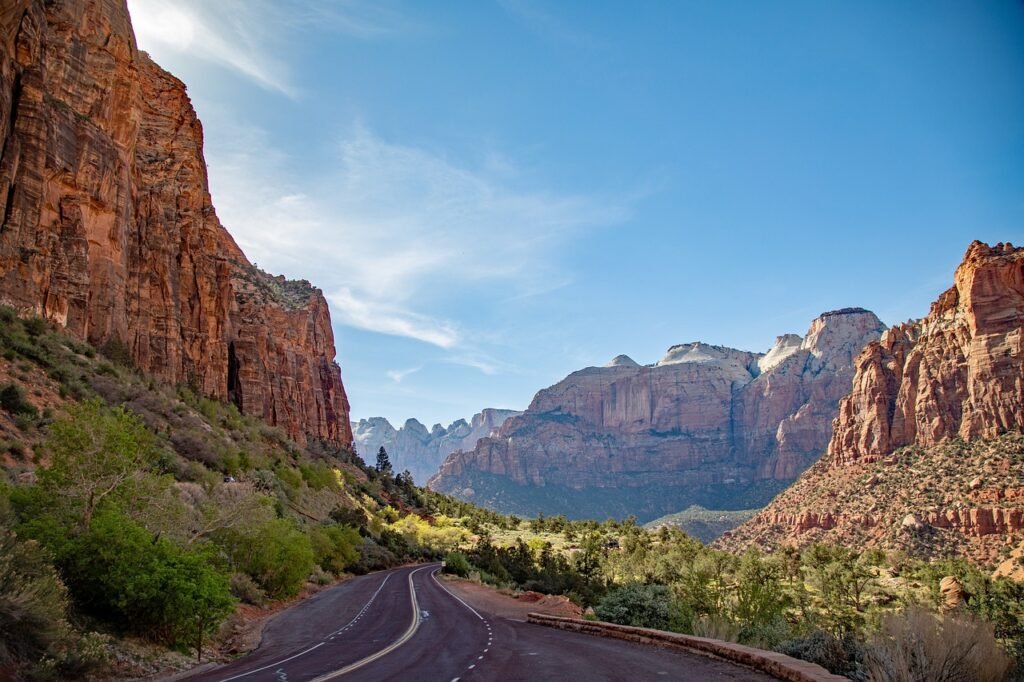Planning your first trip to Zion National Park can be an exciting adventure. Zion, located in southwestern Utah, is one of the most popular and stunning national parks in the United States, famous for its red rock cliffs, narrow slot canyons, and breathtaking vistas.
Whether you’re planning on hiking the famous Angels Landing or simply soaking in the beauty of Zion Canyon, this guide will help you prepare for your first adventure to this magnificent park.
1. Best Times to Visit Zion National Park
Zion can be visited year-round, but each season offers a slightly different experience. It’s important to choose the best time based on your interests and what you’re hoping to get out of the trip.
A) Spring – March to May
Spring is one of the best times to visit Zion. The weather is mild, and wildflowers begin to bloom, adding a splash of color to the landscape. The Virgin River, which runs through the park, will be running strong from snowmel.
This makes it the perfect time to explore the Narrows, a popular hike through a slot canyon with the river running at your feet. Just be aware that higher river flows in early spring could make the Narrows inaccessible until later in the season.
B) Summer – June to August
Summer is Zion’s busiest season. If you’re visiting during these months, be prepared for crowds, especially on the popular trails like Angels Landing and the Emerald Pools.
The temperatures can also get very hot, often reaching over 100°F, so it’s essential to start your hikes early in the morning to avoid the heat. Despite the crowds and heat, summer is a great time for longer days, which give you more time to explore.
C) Fall – September to November
Fall is another fantastic time to visit Zion. The weather is cooler, and the crowds start to thin out after Labor Day.
The autumn colors in the park are absolutely beautiful, with red and yellow leaves contrasting against the red rock cliffs. Many consider late September to October to be the ideal time to visit.
D) Winter – December to February
Winter is the quietest time to visit Zion, making it perfect for those who want to avoid the crowds. The temperatures are much cooler, especially in the mornings and evenings, but daytime highs are usually mild.
Snow is rare in Zion Canyon itself, but the higher elevations can receive some snow, adding a magical touch to the landscape. Just be aware that some trails, particularly at higher elevations, may be closed due to snow and ice.
2. Where to Stay in Zion
One of the first decisions to make when planning your trip to Zion is where to stay. There are several options depending on whether you prefer to be close to nature or if you’d rather have the comforts of a hotel.
A) Camping
If you’re an outdoor enthusiast, camping in Zion can be a great way to fully immerse yourself in the beauty of the park.
There are two campgrounds in Zion Canyon: South Campground and Watchman Campground. Both are conveniently located near the park’s shuttle system, which makes getting to trailheads a breeze.
Campgrounds can fill up months in advance, especially during peak seasons, so it’s a good idea to make reservations early. If you’re planning to camp, be prepared for cool nights, even in the summer, and pack accordingly.
B) Zion Lodge
For those who want to stay inside the park but prefer a more comfortable experience, Zion Lodge is the only lodging option within Zion National Park. It’s located right in the heart of Zion Canyon, and staying there allows you to be close to many of the park’s most popular attractions. Rooms at Zion Lodge tend to book up far in advance, so be sure to plan ahead.
C) Outside the Park (Springdale)
If you can’t find accommodations inside the park or prefer staying in a nearby town, Springdale is the place to be.
This charming town is located just outside Zion’s entrance and offers a range of hotels, vacation rentals, and restaurants. Staying in Springdale gives you easy access to the park via the shuttle system, which runs from the town to the park entrance during peak season.
3. How to Get Around Zion

Zion has a shuttle system that operates in Zion Canyon from early spring to late fall. It’s an excellent way to get around the park without the hassle of parking.
During peak season, private vehicles are not allowed in Zion Canyon, so the shuttle is your best bet for getting to trailheads and popular sites.
The shuttle system is free and runs frequently, with stops at major trailheads like The Grotto, Weeping Rock, and the Temple of Sinawava (the starting point for the Narrows hike).
If you’re visiting during the off-season when the shuttle isn’t running, you can drive your own vehicle through Zion Canyon, but parking is limited.
If you’re planning to explore areas outside of Zion Canyon, such as Kolob Canyons or the Kolob Terrace Road, you’ll need your own vehicle. These areas are less crowded than Zion Canyon and offer stunning views and less-traveled hiking trails.
4. What to Pack for Zion National Park
Packing for Zion depends on the season and what activities you plan to do, but there are a few essentials that will make your trip more enjoyable.
Layered Clothing: Zion’s weather can be unpredictable, especially in the spring and fall when temperatures can fluctuate throughout the day.
Mornings and evenings can be chilly, while midday temperatures can be quite warm. Packing layers will help you stay comfortable as the weather changes. Bring a mix of short-sleeve shirts, long-sleeve shirts, a lightweight jacket or fleece, and a lightweight rain jacket in case of showers.
Sturdy Footwear: Whether you’re hiking Angels Landing, wading through the Narrows, or exploring the park’s scenic overlooks, you’ll need sturdy footwear. Hiking boots or shoes with good grip are a must for Zion’s rugged terrain.
If you plan to hike the Narrows, water shoes or closed-toe sandals with good traction are essential since you’ll be walking in the river.
Daypack: A daypack is essential for carrying your gear during hikes. Be sure to pack plenty of water (Zion can get very hot, and dehydration is a real risk), snacks, a hat, sunglasses, sunscreen, and a small first-aid kit.
Hydration System: Zion can get extremely hot in the summer, and even during cooler months, staying hydrated is key. A hydration pack or water bottles that you can easily access while hiking will make it easier to keep drinking throughout the day.
Sun Protection: The sun in Zion is intense, especially during the summer. Be sure to bring sunscreen, a wide-brimmed hat, and sunglasses to protect yourself from the sun’s rays. Even on cloudy days, UV rays can be strong, so it’s important to stay protected.
Trekking Poles (Optional): If you’re planning to hike the Narrows or tackle some of Zion’s steeper trails, trekking poles can provide extra stability. They’re especially helpful when hiking in the river or navigating uneven terrain.
5. Must-See Hikes and Activities
Zion is known for its world-class hiking, but if you’re new to the park, it can be overwhelming to know which trails to prioritize. Here are a few must-see hikes and activities for first-time visitors.
A) Angels Landing
Angels Landing is one of the most iconic hikes in the park, known for its steep switchbacks and narrow ridge with drop-offs on both sides. While it’s not for the faint of heart, the views from the top are absolutely stunning.
If you’re considering this hike, be prepared for a strenuous climb and know that you’ll need to secure a permit. The permit system was introduced to manage crowds.
B) The Narrows
Hiking the Narrows is a unique experience that involves wading through the Virgin River as it winds through a narrow slot canyon. It’s one of Zion’s most popular hikes, and for good reason.
The towering canyon walls and cool river water make for an unforgettable adventure. Be sure to check the river conditions before starting this hike, as high water levels can make it unsafe.
C) Emerald Pools
If you’re looking for a shorter, more accessible hike, the Emerald Pools Trail is a great option. This trail takes you to a series of beautiful pools and waterfalls and offers stunning views of Zion Canyon.
There are three pools to visit—Lower, Middle, and Upper Emerald Pools—so you can choose how far you want to hike.
D) Observation Point
For those looking for a less crowded alternative to Angels Landing, the Observation Point hike offers equally breathtaking views. The trail is longer and gains more elevation, but the reward at the top is a panoramic view of Zion Canyon that’s hard to beat.
E) Canyoneering
Zion is also a top destination for canyoneering, which involves rappelling and navigating narrow canyons. If you’re up for an adventure, consider booking a guided canyoneering trip to explore Zion’s hidden slot canyons.
This activity is best suited for those with some experience, but beginner-friendly trips are available as well.
6. Safety Tips for Zion
Zion National Park is a beautiful but rugged environment, and it’s important to stay safe while exploring. Here are a few safety tips to keep in mind.
A) Stay on Designated Trails
Zion’s trails are well-marked, and it’s important to stay on designated paths to protect both yourself and the park’s fragile ecosystem. Straying from the trails can lead to dangerous situations, such as falls or getting lost.
B) Bring Plenty of Water
Dehydration is a real concern in Zion, especially during the hot summer months. Be sure to bring enough water for your hikes—experts recommend at least one liter per hour of hiking. Zion has water refill stations at various locations, so take advantage of them.
C) Check the Weather
Zion’s weather can change quickly, especially in the spring and fall. Check the forecast before you head out for the day, and be prepared for sudden changes. Flash floods are a concern in slot canyons, including the Narrows, so always check for flood warnings before setting out.
D) Know Your Limits
Some of Zion’s hikes, like Angels Landing and the Narrows, are physically demanding. Be honest about your fitness level and choose hikes that match your abilities. It’s better to take it slow and enjoy the experience than to push yourself too hard and risk injury.
Final Thoughts: Embrace the Adventure
Your first trip to Zion National Park will be a memorable experience filled with adventure and breathtaking scenery. By planning ahead, packing the right gear, and taking time to appreciate the beauty around you, you’ll be well-prepared for everything this incredible park has to offer.
Whether you’re hiking the iconic Angels Landing, marveling at the Narrows, or simply soaking in the views from Zion Canyon, you’re in for an unforgettable adventure. Take your time, stay safe, and enjoy every moment in this remarkable place!
Explore more. Fear less.
- Why Road Trips are One of the Best Ways to Clear Your Mind - November 21, 2024
- 10 of the Best Pumpkin Patches in the U.S. - October 23, 2024
- 10 of the Most Colorful Fall Road Trips in the U.S. - October 22, 2024
